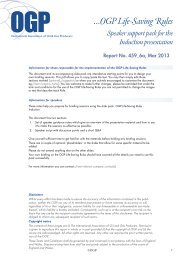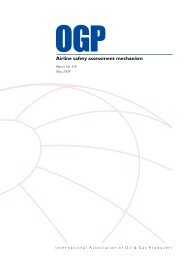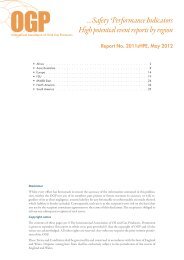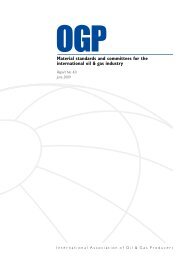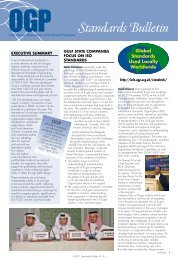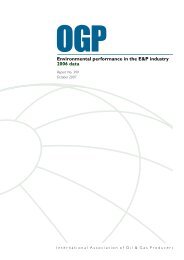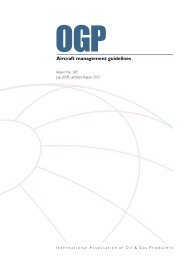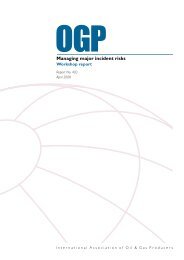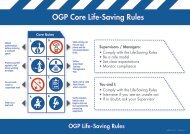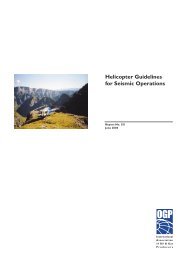Helicopter guidelines for land seismic & helirig operations - OGP
Helicopter guidelines for land seismic & helirig operations - OGP
Helicopter guidelines for land seismic & helirig operations - OGP
Create successful ePaper yourself
Turn your PDF publications into a flip-book with our unique Google optimized e-Paper software.
<strong>Helicopter</strong> <strong>guidelines</strong> <strong>for</strong> <strong>land</strong> <strong>seismic</strong> & <strong>helirig</strong> <strong>operations</strong><br />
B.2.2<br />
B.2.3<br />
Design breaking strength and design factor: wire rope, straps, slings, shackles, and<br />
swivels should have a design breaking strength of five (5) times the rated WLL (a<br />
design factor of “5”). Synthetic fiber rope and slings require a higher safety factor and<br />
breaking strength as synthetic materials are more vulnerable to the environmental<br />
conditions. It is recommended to use a designed breaking strength of at least seven (7)<br />
times the rated WLL (a design factor of “7”) <strong>for</strong> synthetic fiber rope and slings.<br />
Proof testing: After manufacture, all items should be proof tested to twice the WLL<br />
by the manufacturer or test facility. Test certificates are to be retained until the item is<br />
scrapped and should provide the WLL, design factor or design breaking strength, and<br />
the proof testing results.<br />
Table 1: Example of <strong>OGP</strong> recommended working loads, and design and initial testing ratings<br />
A helicopter will be lifting <strong>seismic</strong> drills weighing 1,850 pounds. Operator will use a cargo hook rated at<br />
4,000 pounds maximum capacity. Shown are <strong>OGP</strong> <strong>guidelines</strong> <strong>for</strong> any item of lifting equipment.<br />
<strong>OGP</strong> recommended<br />
minimum WLL<br />
of any lifting<br />
equipment item<br />
<strong>OGP</strong> recommended<br />
design factor<br />
(safety factor)<br />
Minimum design<br />
breaking strength<br />
(by manufacturer)<br />
Proof testing load<br />
(by manufacturer or<br />
test facility)<br />
Calculation used Hook capacity Per ASME WLL x design factor 2 x WLL<br />
Wire rope/sling 4,000 lbs. 5 20,000 lbs. 8,000 lbs.<br />
Synthetic fiber rope 4,000 lbs. 7 28,000 lbs. 8,000 lbs.<br />
B.3 Markings and records<br />
Note: The manufacturer shall identify slings initially. The user shall maintain the sling<br />
identification during the life of the sling. Replacement of the identification shall be considered a<br />
repair to be completed by the manufacturer or person/organization approved in accordance with<br />
recognized standards.<br />
B.3.1<br />
B.3.2<br />
B.3.3<br />
B.3.4<br />
All cables, slings and straps should be tagged or marked to show the name or<br />
trademark of manufacturer and the swaging collar embossed with:<br />
1. A reference number.<br />
2. Rated load limit (WLL). Note: Some countries may use SWL or “rated capacity.”<br />
3. Diameter or size, and length of the sling.<br />
4. Date of next <strong>for</strong>mal inspection.<br />
All other lifting items should be stamped or marked to show a reference number,<br />
and WLL.<br />
If it is not practical to mark the required items, a suitable color code should be used.<br />
An appropriate maintenance program should be developed <strong>for</strong> all items, which<br />
provides a traceable record of testing and inspections. A useful tool <strong>for</strong> this is a ‘sling<br />
register’ in which a full inventory is kept of all slings and other lifting equipment<br />
as well as the type of attachments and shackles etc., in use, documenting age, date<br />
put into service, inspection and replacement cycle and dates and, where appropriate,<br />
maximum wear allowed.<br />
© <strong>OGP</strong><br />
47



